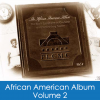Advanced Search
"As we treasure our past, we enrich our todays and strengthen our tomorrows."
Dr. Marjorie Parker
March 15, 1992 - The Public Library of Charlotte and Mecklenburg County publishes An African American Album. Families throughout the community have shared their treasured photographs.
Unknown African American Company. African American troops began arriving in earnest in late 1918. Their numbers equaled and sometimes exceeeded the numbers of white troops in Camp Greene at the same period.
An African American Album: The Black Experience in Charlotte and Mecklenburg County was first published as a book of photographs in 1992. It documented the community's history up to 1950.
March 15, 1992 - An African American Album is presented to the public.
The first school for 253 black students opens in the basement of the black community's Episcopal Church. An important advocate for blacks arrives: Dr. J.T. Williams, a renowned doctor and educator.
November 3, 1992 - Charlotte's Mel Watt and Warrenton's Eva Clayton are the first blacks from North Carolina elected to the U.S. Congress since the era that followed the Civil War more than 100 years ago.
Grace African Methodist Episcopal Zion Church was founded by four men and seventeen women in December, 1887. The Church moved into this building in 1900.
LAURA M. BOOTON.
December 14, 1976 - Charlotte's African American women are honored by UNC.
November 3, 1992 - Watt and Clayton are elected to Congress.
March 15, 1986 - The Afro-American Cultural Center opens. It is located in the old Little Rock AME Zion Church on the edge of the First Ward neighborhood. The center sponsors theater, art and exhibitions that celebrate the African American history of Charlotte.
Built in 1900, Grace African Methodist Episcopal Zion Church is still located at 209-211 South Brevard Street. The building is no longer open to the public, but i
In 1911, you might have seen men moving the Little Rock AME Zion Church from its original location in the Third Ward to Myers Street which was in First Ward.
NC pays tuition for African Americans to attend universities.
This is a special project of the Public Library of Charlotte and Mecklenburg County in celebration of the Library's centennial year. It addresses a long-standing need to record and preserve the visual history of the African American Community.
One of the most important agencies for maintaining cohesion and rendering social welfare was the church. In slavery, the church played a vital role in attending to the spiritual and social needs of slaves as well as aided in the successful escape of slaves to freedom.
Local governments must often make unpopular decisions about how to deal with areas of substandard housing and roads. In poor or run-down neighborhoods, it can be difficult to determine whether the cost of fixing up old buildings is worth the expense.
The division of Charlotte into four wards was a natural progression. The crossroads Trade and Tryon Streets had long existed as trading paths.












